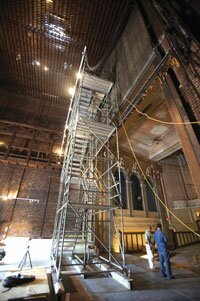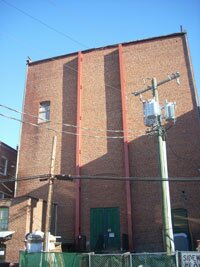ON ARCHITECTURE- Curtain call: Opera company, Capshaw part ways

"The scope and scale of the project just shifted dramatically with the opera pulling out," project manager Kirby Hutto explains.
FILE PHOTO BY MICK TAVISH
When the renovation of the Jefferson Theater began last August, shortly after a partnership between owner Coran Capshaw and Ash Lawn Opera Company was announced, project manager Kirby Hutto said that a September 1, 2009 opening for the music venue was "set in stone." But following the announcement last week that the opera company wanted out, the project, which has been in the works for almost three years, appears to be in limbo.
"The scope and scale of the project just shifted dramatically with the opera pulling out," Hutto explains. "Last time we spoke, the opera board had approved an agreement that gave us a clear direction on the project. Now we have to pause and go backwards to find the path forward, and that will take some time."
Last August, the opera company announced with great excitement that it was partnering with Capshaw and embarking on a $4.5 million capital campaign to pay for some of the $7.5 million in improvements slated for the Jefferson, which would have included a 50-person orchestra pit, dressing rooms, and a special HVAC system. In return, the Company would get a 20-year summertime lease from Capshaw. The idea was that Ash Lawn would basically take over the space during the summer opera season, when Capshaw's outdoor Pavilion was in full swing.
"I cannot tell you," said Company director Judy Walker at the time, "how happy our company will be– to not have to worry about humidity and drippy trees, for our singers not to have to duck behind bushes for quick changes, for people to have comfortable chairs, and for us to use real theater paint and not waterproof Sears Weatherbeater paint."
Since 1978, the opera company has dodged raindrops, newlyweds, and the occasional strolling peacock to present outdoor opera at Ash Lawn-Highland, the home of fifth president James Monroe.
"It is so exciting to think of an opera house and a rock theater coming together as one," said Walker.
Unfortunately, that's a duet we won't be hearing.
"As we got further into the design process," says attorney Frank Buck, president of the opera company's board, "the realization hit us that it just wasn't going to make sense."
Because opera doesn't use amplification, the building had to be virtually sound proof, Buck explains, which seemed to drive the costs up at every design turn. For example, Buck says the HVAC system had to be located in a place where it wouldn't create any sound or cause any vibration. A place was found on the roof, but the regular duct work would have been too heavy a load for the old theater's roof. Expensive aluminum ducts would need to be used. In addition, a special soundproof room was needed for the fans that would cool the intense lighting needed for performances. And that's not to mention the huge orchesta pit and the dressing rooms.
"The costs kept escalating, and we didn't want to compromise," says Buck. While he says the opera company is financially healthy, having recently received $1 million in pledges, he admits that the bad economy was "without a doubt" a concern moving forward.
For now, the Company will stay put dodging peacocks and raindrops at Ash Lawn, and it plans on putting on two or three shows at the Paramount Theater. And there's a chance, says Buck, that the company may be partnering with the Paramount in the future, but nothing has been decided yet.
As for the Jefferson, losing the opera company as a partner is a cause for regret and could delay the project.
"If the opera had come on board, we would have come up with a much better project," says Hutto, referring to what would have been built into the design to accommodate them. "It really could have been great, but because of the economy..."
Hutto says that much of the design work for the theater will now have to be re-bid.
"We will have to go back to the design and take out what the opera wanted," he says. "There's a big difference between what we had planned to do with the opera, and what we plan to do now without them."
Fortunately, though, those plans won't have to include an orchestra pit or a completely silent-running HVAC system. It will still include a killer sound system for a music hall/night club presenting between 12 and 18 shows a year. The space will also be available for rent and will serve the book, film, and photo festivals.
In addition, Hutto says, there will be a small club below the lobby with room for 100 people, and a Mall-front restaurant in the old Innisfree World Artisans/Obama headquarters with a kitchen below.
The good news, says Hutto, is that "a ton" of work has been done on the building, including all the demolition, asbestos removal, infrastucture for utilities, and almost all the structural work. Hutto says that managing an urban construction project of this scale has proved to be a challenge. For example, two 65-foot-tall steel I-beams had to be attached to the Water Street side of the building after engineers determined the brick wall was beginning to bow; and it had to be done while surrounded by a tangle of above-ground utility poles and power lines without seriously disrupting traffic.
This time, however, Hutto isn't about to set anything in stone.
"We were aiming for an opening this fall, and that could still happen," says Hutto. "But I can't say when the theater will open."
Meanwhile, for the curious, the contractor on the project, Martin Horn Inc., has setup a webcam in the Jefferson that can be viewed by visiting www.martinhorn.com.

After engineers discovered that the wall on the Water Street side of the Jefferson Theater was beginning to bow, it was secured with two 65-foot steel I-beams.
PHOTO BY DAVE MCNAIR
#